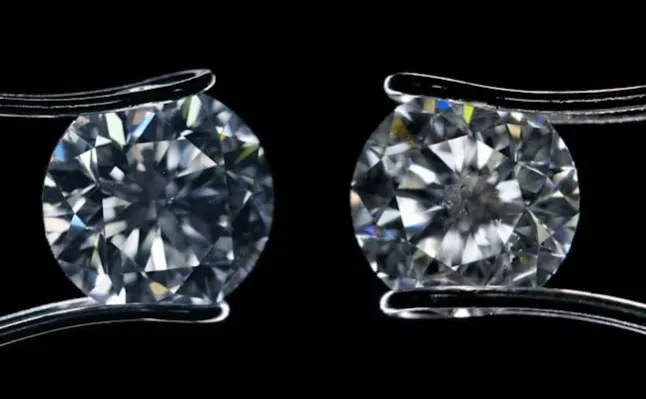What is Diamond Clarity Chart? | 4C's Education
A comprehensive guide to the art and science of diamond clarity
- Clarity reflects internal (inclusions) and external (blemishes) flaws.
- Graded from Flawless (FL) to Included (I3).
- Many inclusions are unseen without magnification - we call this "eye-clean"
- Higher clarity increases rarity and price.
- Choose clarity based on look and budget.
Fast Facts on Diamond Clarity
- Diamond clarity grade refers to how many imperfections are present in a diamond.
- These imperfections might be internal inclusions or blemishes on the surface of the stone.
- The clarity characteristics can save you money or cost you a dull looking stone, depending on how you use them.
Diamond Clarity Explained
Let’s start with the basics. When we talk about the clarity of a diamond, we are referring to how many - or indeed how few - natural imperfections are present in the stone. These imperfections are generally called inclusions (found within the diamond) or blemishes (found on the surface of the diamond). These imperfections can be your (wallet’s) best friend or worst enemy, depending on how you utilize them. By now I’m sure you have come across the ubiquitous (yet kind of weirdly worded ‘slightly/very slightly/very very slightly included’) GIA clarity scale from the Gemological Institute of America. But just in case you have not, here it is again;
Diamond Clarity Chart

There are 6 Clarity Categories With a Total of 11 Clarity Grades
FL (Flawless)
- Completely inclusion and blemish free
- Incredibly rare and expensive
IF (Internally Flawless)
- Completely inclusion free internally
- Has some very minor surface blemishes that are difficult to see even with a trained eye at 10x magnification
- Every IF diamond is eye clean
VVS1 & VVS2 (Very Very Slightly Included)
- Incredibly microscopic inclusions that are difficult even for a trained grader to see under 10x magnification
- All VVS diamonds will be eye clean - brilliant and step cut
VS1 & VS2 (Very Slightly Included)
- Minor inclusions ranging from hard to see at 10x (VS1) to slightly easy to see with a trained eye at 10x (VS2)
- VS1 or higher will be eye clean for brilliant cut and most step cut stones
- The VS range is the most often searched on Rare Carat
SI1 & SI2 (Slightly Included Diamonds)
- Inclusions are noticeable with 10x magnification
- Look hard enough, and you'll see them with the naked eye
- If eye clean, can be considered a great value
- Better for brilliant cut diamonds vs. step cut
I1, I2 & I3 (Included Diamonds)
- An I clarity graded diamond is going to have visible inclusions that are easily spotted without magnification
- I clarity diamonds are not as durable due to the multiple inclusions
- Rare Carat does not list I clarity diamonds
Which Clarity Grade Should I Buy?
I want to break down the diamond clarity scale a little for you, and by doing so hopefully, you can cherry-pick the range that works best for you. Now, first of all, here’s a small home truth. Worrying about inclusions in a diamond that is graded anywhere above VS2 is probably not the best use of your time. Anything from VS1 to FL is going to be eye-clean, meaning these inclusions will definitely not be visible to the naked eye (not even those beady eyes of your cousin Brenda). On the other hand, trying to find a good quality diamond in the I1, I2 or I3 clarity grades, will be like trying to find a parking space at Walmart on Black Friday (not entirely impossible, but super time consuming and kind of depressing). Inclusions in this range are usually (but not always) visible to the naked eye. In fact, visible inclusions can be so prominent that they negatively impact the way the light travels through the stone, ruining the fire and brilliance and all those awesome things that make a diamond so beautiful.
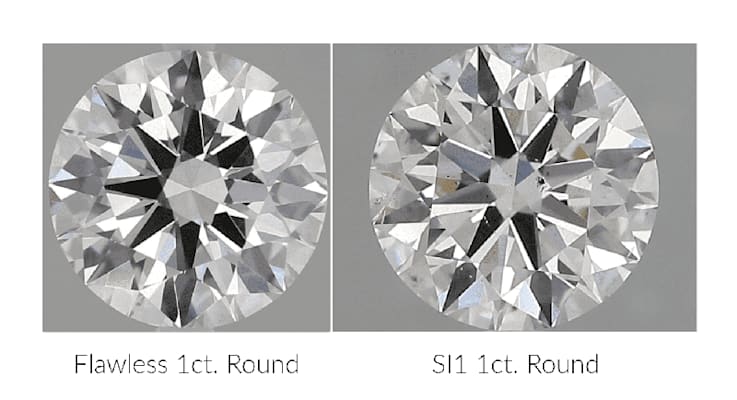
Of course, if you want to buy a higher clarity stone, this is completely fine, and many people do want to go for the absolute best their money can buy with a flawless diamond. However, it is best to go into this type of purchase with your eyes open, knowing in this case that you’ll most likely be forking out your hard-earned cash for a feature that will not actually be noticeable to the untrained or unaided eye.
VS2 and SI1 are the holy grail of diamond clarity.
Equally, it is possible to find I1 diamonds that are pretty, especially if you don’t mind a few character flaws. You might hit the jackpot and find an I1 that is eye-clean, even if the inclusions are very obvious under 10x magnification. This is the diamond equivalent of the classic movie makeover scene; at first, it looks like the situation is bleak, but with a few crafty teenage girls (or skilled jeweler) a beauty can be created... until the character realizes at the end that she was beautiful on the inside all along! Yay, Hollywood.
I hope by now you see where I’m going with this people; VS2 and SI1 are the holy grail of diamond clarity. Within this range, you are most likely to find a gorgeous eye-clean diamond that doesn’t cost the same as a small car (#winning). This does NOT mean, however, that you are home-free and will definitely find a fantastic stone within this range. Just like the opening scene in Raiders of the Lost Ark, there are pitfalls and traps that many before you have fallen prey to. With that in mind, here are a few key things to identify regarding the inclusions within the stone before you take the plunge;
There are Five Factors When Considering Inclusions
- Size: The larger the inclusion, the easier it is to see and the lower the clarity grade.
- Number: Typically, the more inclusions the lower the clarity grade. This also depends on the other factors though. A VS1 can have 5 pinpoints whereas a VS2 can have two crystals, but, since crystals are larger than pinpoints (and usually darker), the stone with 2 inclusions will still get the lower clarity call.
- Location: This one is important! Where are the most prominent inclusions located? If under the table, they will be more easily seen than compared to near the girdle's edge or in the pavilion (bottom).
- Nature: The nature of an inclusion relates to how much of a durability impact it will have on the diamond. A pinpoint is going to be less of a risk compared to a cavity.
- Color and Relief: The darker the inclusion, the easier it is to see. Relief relates to how well the inclusion blends in with the rest of the stone.
What Size are the Inclusions?
This is an important factor to consider when looking to see if a diamond will be eye clean, especially when it comes to the mid-clarity ranges of VS2-SI2. Something to always keep in mind with clarity, the larger the diamond, the easier it will be to see the inclusions. A large, dark crystal smack dab in the center of a 5 carat diamond will be significantly easier to see than if it were in the center of a 1 carat. To avoid this problem, I would suggest going for at least a VS2 if you are thinking of purchasing a diamond over 1.5 carats, just to be safe. Now, let's compare apples to apples here, and look at two 1 carat diamonds.
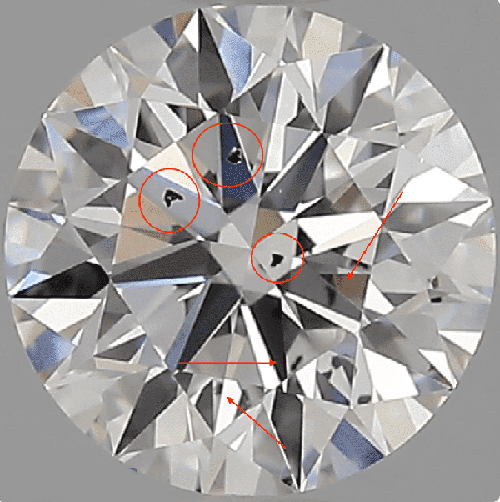
This first diamond (we'll call it diamond A) has large, black inclusions (circled in red) that are scattered throughout the stone. They are also reflecting (more about that in the next section).
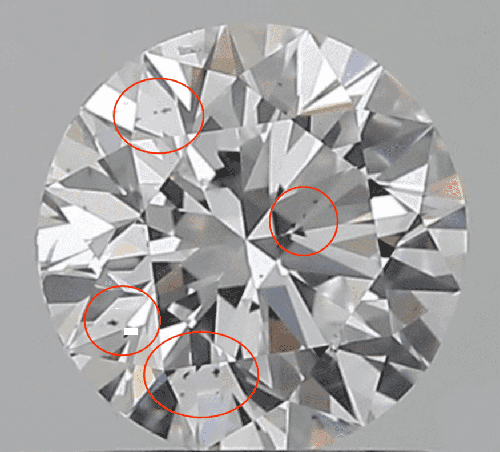
This second diamond (we'll call it diamond B) has more inclusions, but they are a lot smaller so they are harder to see.
Both of these stones are 1 carat SI1's, but look very different based on the size of the inclusions as well as the other clarity factors.
How Many Inclusions are There?
Not only do we care about the size of the inclusions, but also the amount. One large, dark crystal in the center can be worse than 5 small light crystals on the sides. We also need to take into consideration reflections. Sometimes, a crystal or other type of inclusion can be in just the right spot within the diamond that its reflection bounces off the facets making it look like the stone is more included than it actually is. Take a look again at Diamond A and you'll see what I mean. All of those red arrows are pointing at reflections, not actual inclusions. Pretty crazy, right?
Where are the Inclusions Located?
The location of the inclusions is crucial both in terms of the stone’s aesthetics and its durability. Aesthetically speaking, if you have a fairly large inclusion but it is positioned in such a way that an engagement ring setting with disguise it, then this might be a great option for you. However, if the same flaw is smack bang in the center of the table, not only might you be able to see it more easily, but it could also hamper the way the light travels through the stone which will impact the overall look of the diamond. When it comes to inclusions that can impact a diamond’s durability, you might be looking at imperfections that lay near the girdle (edge) of the stone. Over time this will be more vulnerable to chipping, even on the most responsible of hands.
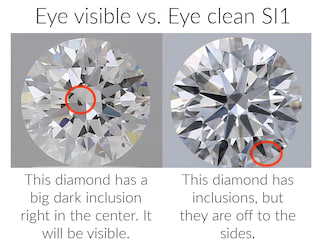
What Type of Inclusions (nature)?
Just like potential mates, there are many types of inclusions and not all are created equal. While some might be tiny flaws (didn’t wash your cup after coffee? No biggy) others can be glaringly obvious issues that need to be someone else’s problem. For example, you might have a diamond with a large crystal, but that crystal is almost translucent and therefore isn’t that noticeable (dirty coffee cup scenario). On the other hand, the crystal might be black - which is not only noticeable but could actually reflect inside the stone in such a way that it looks like there’s more than one.

What Color are the Inclusions?
Just like the location, size, amount and type of inclusions is important, so is the color. When you have black or fairly dark inclusions, they are going to be more easily seen. When you have colorless or white inclusions, they will blend in with the rest of the stone and be harder to see.
Using everything you just learned about the location, size, amount, color and nature of inclusions, do you like diamond A or B better? I'll take the one on the left, please!
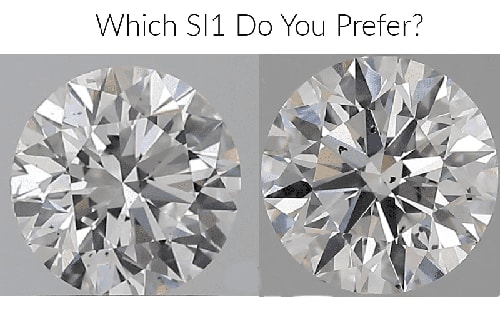
Let’s Talk About Clarity Plots
A clarity plot is a little diagram found on most grading reports for diamonds 1ct or above and is basically a map of where the inclusions are within the stone. Think of these plots as a bit like movie trailers, in that they can be a great way to get your bearings and pick up some information on what to expect. However, just like an awesome trailer for what turns out to be a terrible film, they can be misleading. The problem lies in the fact that the plot cannot tell you what the diamond looks like in real life. Let’s look at an example:
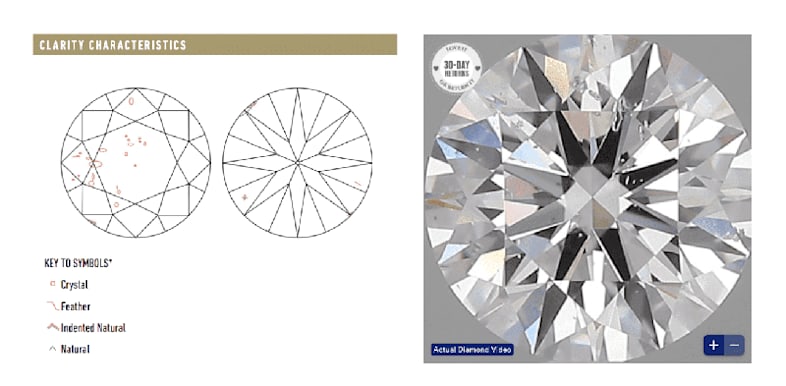
The plot looks promising, with only a few small crystals dotted around the center of the table. However, the real thing is a bit of an anti-climax. For example, we didn’t know that these crystals were black and reflecting in such a way that it’s making the stone look even dirtier. On the other hand, a messy plot doesn’t have to mean a bad looking diamond! Let’s take a look at our ‘coffee cup in the sink’ diamond;
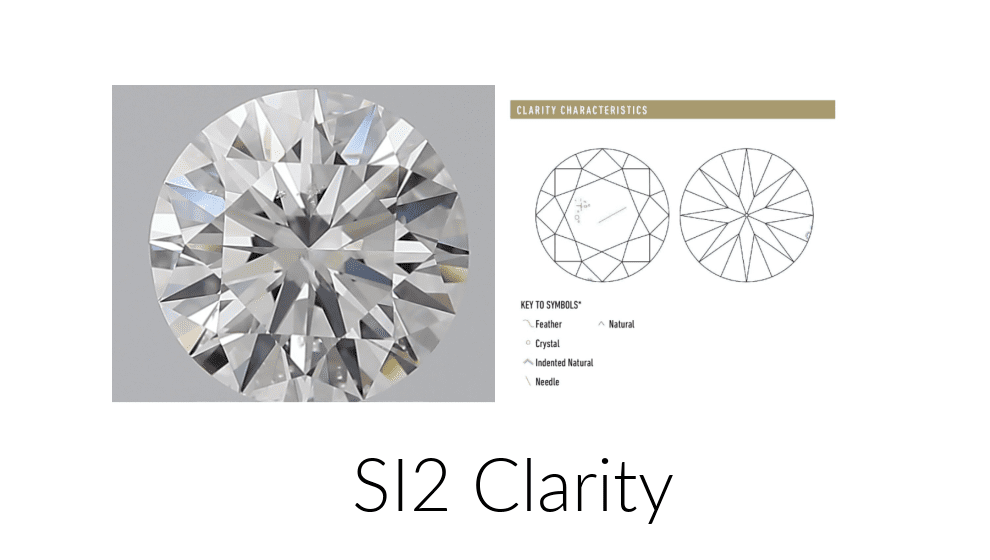
Just looking at the plot this diamond looks like it’s going to be all types of trouble, but IRL it isn’t that bad! Add to that the fact that this is 10x magnification, and those inclusions will be hard to spot with the naked eye.
Both of these stones are actually graded as SI2 but perform very differently. Because diamond grading is not an exact science, and because these clarity grades are ‘ranges’, our coffee cup diamond (although graded as an SI2) might in fact be on the cusp of an SI1 while our other diamond could be SI2 bordering I1. This is very important to understand, especially if you are presented with a list of diamonds that look identical but are still priced differently. When you take a closer look, you might learn that they are less ‘Mary-Kate and Ashley Olsen’ and more ‘Arnold Schwarzenegger and Danny DeVito’.
What is the moral of this very long story? Relying on a grading report alone is a bad idea. Using them as a tool is great, but in order to make sure you are getting the best bling for your buck, make sure you have access to a 10x magnified picture at the very least (and if they are not readily available, ask a gemologist!). That way you can identify those pesky DeVito's.
Until next time (I couldn’t resist, nor should I)...
Read More...
VVS1 (Very Very Slightly Included)
VVS2 (Very Very Slightly Included 2)
VS2 (Very Slightly Included 2)
Which Diamond Inclusions are the Worst?
Whats the best cut grade for the shape? Rare Carat Ideal! Check it out here
Looking for a deal? Check out all of our promos here
Are inclusions bad in a diamond?
How do inclusions affect a diamond?
Inclusions can also affect the durability of the stone depending on the type and placement of certain inclusions. We recommend avoiding inclusions that hinder the durability of the stone like cavities, knots, laser drill holes, etch channels and chips. All of these can cause future damage to the stone if hit in these areas and are ones to always avoid. It’s also a good idea to avoid any inclusions that are near corners or points of any stones as these areas are more vulnerable to chipping or breakage.
Lastly if there are enough inclusions, it can hinder the light return and overall brilliance of the stone. This is because the light hits the inclusions and bounces out of the sides or bottom of the stone as opposed to returning back to your eye as sparkle. We recommend staying within the Flawless to SI2 clarity range as anything lower in clarity will have more chances of any of these affecting the stone.
